In 2025, the cost of electricity in Nigeria continues to rise. Between frequent PHCN blackouts, soaring diesel generator costs, and the removal of fuel subsidies, many households are spending tens of thousands of naira monthly just to keep basic appliances running.
The good news? Solar energy has become more affordable and accessible than ever.
Also Check:
Free Solar Installation Training in Nigeria – Register Now to Build a Sustainable Career
Solar Installer Certification in Nigeria — Requirements and Process
A well-designed solar system can:
- Keep your home powered during blackouts
- Reduce your reliance on expensive generators
- Lower your monthly energy bills
- Increase the value of your property
But here’s the catch: you must size your solar system correctly. If you undersize, your batteries will drain quickly and appliances may fail to run. If you oversize, you’ll waste money on unnecessary equipment.
This step-by-step guide shows you how to size a solar system for your home in Nigeria, with real calculations, charts, and examples tailored to Nigerian households.
Step 1: List Your Appliances
Every solar system starts with understanding your daily energy needs. List out every appliance you plan to power.
| Appliance | Power Rating (W) | Hours of Use/Day | Energy Used (Wh) |
| LED Bulbs (10 × 10W) | 100 | 6 hrs | 600 |
| Refrigerator | 150 | 10 hrs (cycles) | 1,500 |
| TV | 100 | 5 hrs | 500 |
| Ceiling Fans (3 × 70W) | 210 | 8 hrs | 1,680 |
| Laptops (2 × 60W) | 120 | 6 hrs | 720 |
| Total | — | — | 5,000 Wh (5 kWh) |
✅ This family consumes 5 kWh of electricity daily.
Step 2: Calculate Daily Energy Needs
Formula:
Daily Load (Wh)=∑(Power (W)×Hours of Use)\text{Daily Load (Wh)} = \sum (\text{Power (W)} \times \text{Hours of Use})Daily Load (Wh)=∑(Power (W)×Hours of Use)
From our example: 5,000 Wh/day = 5 kWh/day.
Energy Consumption Comparison in Nigeria (2025):
- Small home (1–2 bedrooms): ~2 kWh/day
- Medium home (3–4 bedrooms): ~5 kWh/day
- Large home/duplex: 10+ kWh/day
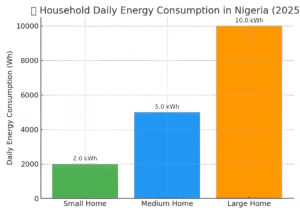
Step 3: Battery Bank Sizing
Batteries are the heart of your solar system. They store energy for night use and during PHCN outages.
Formula:
Battery Capacity (Ah)=Daily Load (Wh)System Voltage (V) × DoD × Efficiency\text{Battery Capacity (Ah)} = \frac{\text{Daily Load (Wh)}}{\text{System Voltage (V) × DoD × Efficiency}}Battery Capacity (Ah)=System Voltage (V) × DoD × EfficiencyDaily Load (Wh)
For our 5 kWh/day household:
- Load = 5,000 Wh
- Voltage = 48V
- DoD (LiFePO₄) = 80%
- Efficiency = 90%
5,00048×0.8×0.9≈145Ah\frac{5,000}{48 × 0.8 × 0.9} ≈ 145 Ah48×0.8×0.95,000≈145Ah
Rounded up: 4 × 200Ah LiFePO₄ batteries = 800Ah @ 48V.
Step 4: Inverter Sizing
The inverter converts DC → AC. It must handle running load + startup surges.
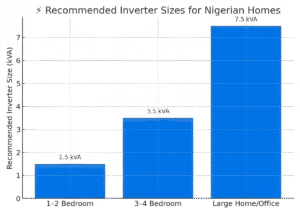
For our 5 kWh home:
- Running load = 1.2 kW
- Surge load = 3 kW
- Recommended inverter = 5 kVA
✅ Rule of thumb:
- 1–2 bedroom flat → 1.5 kVA inverter
- 3–4 bedroom house → 3.5 kVA inverter
- Duplex or office → 5–10 kVA inverter
Step 5: Solar Panel Sizing
Panels must generate enough daily energy.
Formula:
Panel Size (W)=Daily Load (Wh)Sun Hours × Efficiency\text{Panel Size (W)} = \frac{\text{Daily Load (Wh)}}{\text{Sun Hours × Efficiency}}Panel Size (W)=Sun Hours × EfficiencyDaily Load (Wh)
- Load = 5,000 Wh
- Sun hours = 5/day
- Efficiency = 75%
5,0005×0.75≈1,333W\frac{5,000}{5 × 0.75} ≈ 1,333 W5×0.755,000≈1,333W
➡️ 6 × 250W panels = 1.5 kW array
Complete Example: Medium-Sized Home
| Component | Specification | Qty |
| Inverter | 3.5 kVA (48V) | 1 |
| Batteries | 200Ah LiFePO₄ | 4 |
| Solar Panels | 250W | 6 |
| Accessories | Mounts, Cables | — |
Solar System Costs in Nigeria (2025)
| System Size | Inverter | Batteries | Panels | Cost (₦) | Best For |
| Small (2 kWh/day) | 1.5 kVA | 2 × 200Ah | 4 × 250W | ₦500k – ₦700k | 1–2 bedroom flat |
| Medium (5 kWh/day) | 3.5 kVA | 4 × 200Ah | 6 × 250W | ₦1.5M – ₦2M | 3–4 bedroom home |
| Large (10 kWh/day) | 5–10 kVA | 8–10 × 200Ah | 12+ panels | ₦3M – ₦5M+ | Duplex, offices |
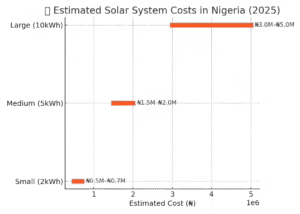
Common Mistakes in Solar Sizing
- Ignoring future needs – plan for expansion.
- Undersizing inverter – fridge/freezer may not start.
- Cheap batteries – lead-acid fails within 2–3 years.
- Poor installation – wrong cable sizes waste power.
- No backup generator – advisable for cloudy days.
Frequently Asked Questions (FAQ)
Q1: How many solar panels do I need for a 3-bedroom house in Nigeria?
A medium-sized 3-bedroom home typically needs 6–8 panels (250W each), depending on daily usage.
Q2: How much does a 5 kVA solar system cost in Nigeria in 2025?
Between ₦2M – ₦3.5M, depending on battery type (lead-acid vs LiFePO₄).
Q3: Which batteries are best for solar in Nigeria?
LiFePO₄ is best. They last 8–10 years vs 2–3 years for lead-acid.
Q4: Can solar run AC in Nigeria?
Yes, but you’ll need at least a 5 kVA inverter + strong battery bank.
Q5: How long do solar panels last?
Panels last 25+ years, though efficiency drops slightly after 10–15 years.
Future of Solar in Nigeria (2025 and Beyond)
- Panel prices are dropping – more Nigerians can now afford solar.
- Lithium batteries are becoming mainstream – replacing lead-acid.
- Government support is rising – new policies encourage renewable adoption.
- Hybrid systems (solar + grid + generator) are becoming the norm.
Conclusion
Sizing a solar system correctly is the foundation of reliable, cost-effective solar power.
Steps recap:
- List appliances
- Calculate daily energy use
- Size batteries
- Choose inverter
- Determine panels
By following this process, you’ll design a system that meets your household needs without wasting money.
👉 Action tip: Write down your daily power usage today and start small — you can always expand your solar system as your budget grows.
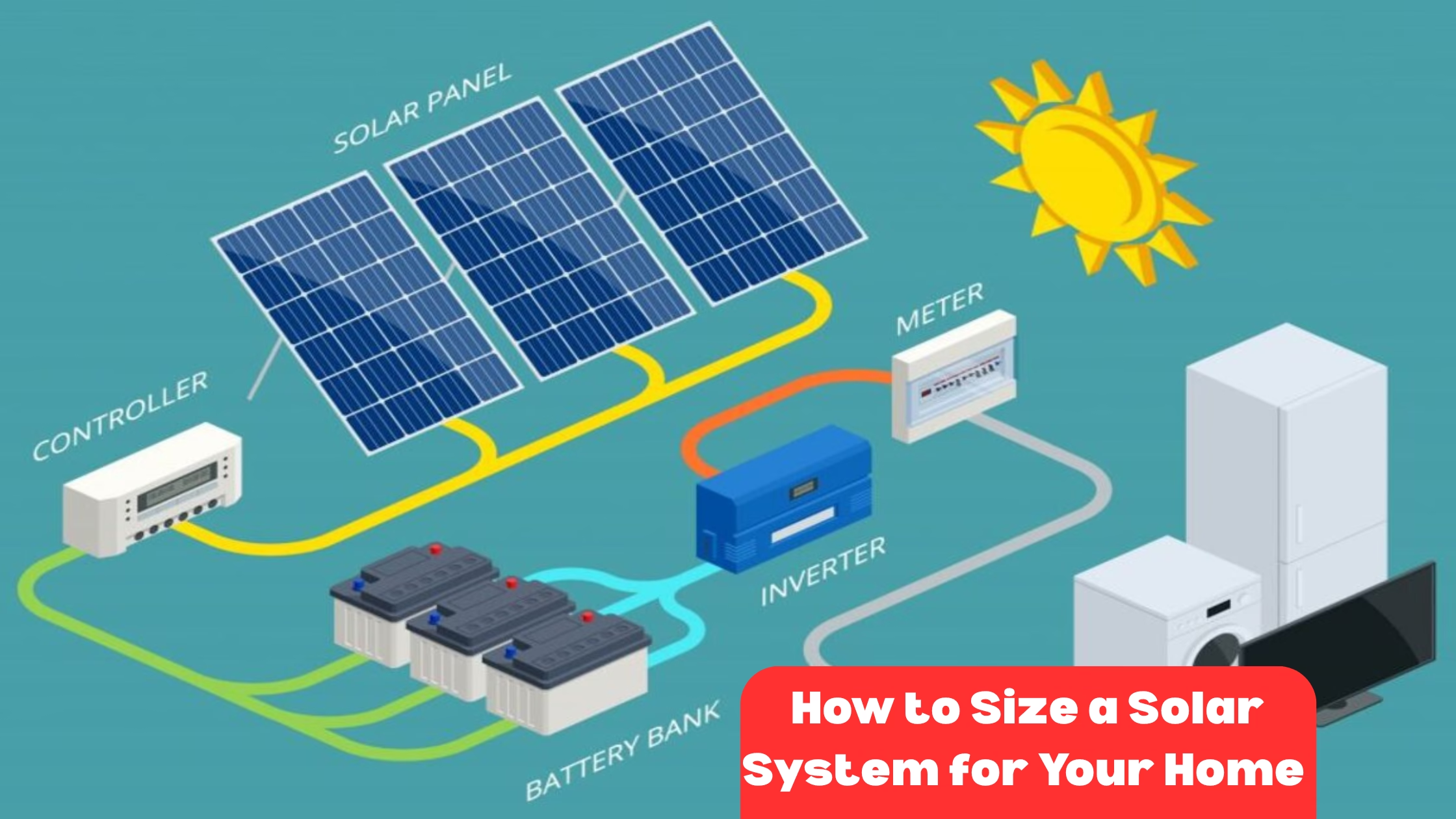
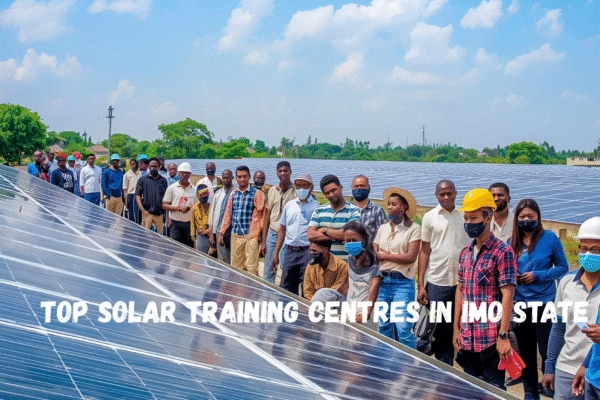
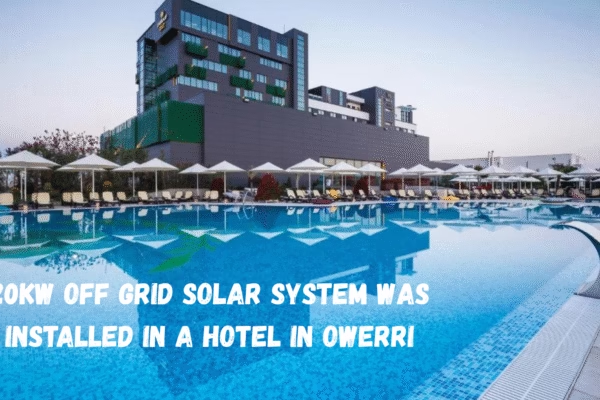


Very lntrested I really appreciate